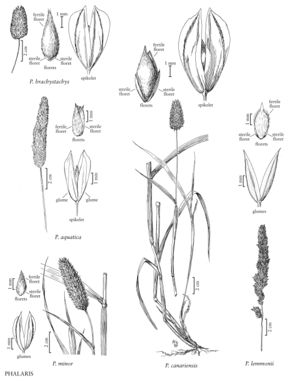Difference between revisions of "Phalaris brachystachys"
FNA>Volume Importer |
imported>Volume Importer |
||
| (4 intermediate revisions by 2 users not shown) | |||
| Line 4: | Line 4: | ||
|publications= | |publications= | ||
|common_names=Shortspike canarygrass | |common_names=Shortspike canarygrass | ||
| + | |special_status={{Treatment/ID/Special_status | ||
| + | |code=I | ||
| + | |label=Introduced | ||
| + | }} | ||
|basionyms= | |basionyms= | ||
|synonyms= | |synonyms= | ||
| Line 17: | Line 21: | ||
-->{{Treatment/Body | -->{{Treatment/Body | ||
|distribution=Tex.;La.;Calif.;Pacific Islands (Hawaii);Mo.;Oreg. | |distribution=Tex.;La.;Calif.;Pacific Islands (Hawaii);Mo.;Oreg. | ||
| − | |discussion=<p>Phalaris brachystachys is native to the Mediterranean region and the Canary Islands, where it grows on waste ground, at the edges of cultivated fields, and on roadsides. It is adventive in northern Europe, Australia, and North America. It is known from a few locations in the Flora region, most of them in California.</p> | + | |discussion=<p><i>Phalaris brachystachys</i> is native to the Mediterranean region and the Canary Islands, where it grows on waste ground, at the edges of cultivated fields, and on roadsides. It is adventive in northern Europe, Australia, and North America. It is known from a few locations in the Flora region, most of them in California.</p> |
|tables= | |tables= | ||
|references= | |references= | ||
| Line 26: | Line 30: | ||
-->{{#Taxon: | -->{{#Taxon: | ||
name=Phalaris brachystachys | name=Phalaris brachystachys | ||
| − | |||
|authority=Link | |authority=Link | ||
|rank=species | |rank=species | ||
| Line 33: | Line 36: | ||
|basionyms= | |basionyms= | ||
|family=Poaceae | |family=Poaceae | ||
| − | |illustrator=Linda | + | |illustrator=Linda Ann Vorobik;Hana Pazdírková |
| + | |illustration copyright=Utah State University | ||
|distribution=Tex.;La.;Calif.;Pacific Islands (Hawaii);Mo.;Oreg. | |distribution=Tex.;La.;Calif.;Pacific Islands (Hawaii);Mo.;Oreg. | ||
|reference=None | |reference=None | ||
|publication title= | |publication title= | ||
|publication year= | |publication year= | ||
| − | |special status= | + | |special status=Introduced |
| − | |source xml=https:// | + | |source xml=https://bitbucket.org/aafc-mbb/fna-data-curation/src/200273ad09963decb8fc72550212de541d86569d/coarse_grained_fna_xml/V24/V24_1089.xml |
|subfamily=Poaceae subfam. Pooideae | |subfamily=Poaceae subfam. Pooideae | ||
|tribe=Poaceae tribe Poeae | |tribe=Poaceae tribe Poeae | ||
Latest revision as of 17:21, 11 May 2021
Plants annual. Culms 80-100 cm. Ligules 4-6(7) mm, rounded, lacerate; blades 4-25 cm long, 3-8(10) mm wide. Panicles 1.5-5 cm long, 0.8-1.8 cm wide, usually ovoid to ellipsoid, occasionally cylindrical, continuous, not lobed, narrowly truncate at the base, rounded at the top; branches not evident, spikelets borne singly, not clustered. Spikelets homogamous, with 3 florets, terminal floret bisexual; disarticulation above the glumes, beneath the sterile florets. Glumes 6-8.5 mm long, 1.4-2.5 mm wide, glabrous or hairy, keels winged on the distal 2/3, wings to 1 mm wide, entire, abruptly pointed; sterile florets 2, subequal to equal, 0.6-1.2 mm, about 1/5 the length of the bisexual florets, with a tuft of hair at the base, otherwise glabrous; bisexual florets 4.4-5 mm long, 1.3-2 mm wide, hairy, shiny, brown to dark brown at maturity, acute; anthers 3-4 mm. 2n = 12.
Distribution
Tex., La., Calif., Pacific Islands (Hawaii), Mo., Oreg.
Discussion
Phalaris brachystachys is native to the Mediterranean region and the Canary Islands, where it grows on waste ground, at the edges of cultivated fields, and on roadsides. It is adventive in northern Europe, Australia, and North America. It is known from a few locations in the Flora region, most of them in California.
Selected References
None.
